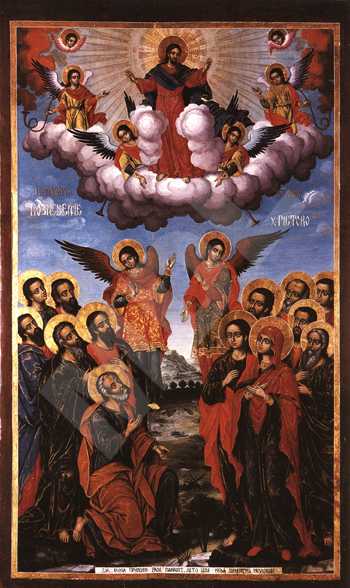The Ascension of Christ
Type:
Icon
Period:
1835 year
Dimiter T. Molerov, born in 1780 in Bansko, son of Toma Vishanov the Moler. One of the best-known painters, a representative of the Bansko school of art, a disciple of his father, influenced by the art of Athos. Author of the murals of the naos in the St Archangels' paraclete in the Rila monastery, the murals in the Church of the Assumption of the Virgin in the Pchelino dependance. In 1840 and 1841 together with his son Simeon Molerov he paints the murals and the sponsors' portraits in St. Nicholas' and St. John of Rila's paracletes in the principal church in the Rila monastery. Among D. Molerov's major achievements in iconography are the following icons: St. Nicholas (1816) from St. Archangel Michael's church in the village of Leshko, Christ All-triumphant with Angels and Cherubim (1833), The Nativity and a Crucifixion from St Elijah the Prophet's church in the village of Usenovo. He has also worked in Belgrade on an invitation by Prince Milosh Obrenovich of Serbia. He died in 1870 in Bansko.
Dimmensions (cm):
105
/ 68.5
/ 3
Location
Country: Bulgaria
Province: Blagoevgrad
Town: Blagoevgrad
Church: Metropolitan church
Source
Country: Bulgaria
Province: Blagoevgrad
Town: Blagoevgrad
Church: Metropolitan church
Description
iconographer has treated the theme in the traditional manner, having situated the figures along the icon's vertical axis. The figures of the twelve disciples are standing and the group is divided into two. In the icon's right-hand side is the Holy Mother of God with six disciples. The other six of them are on the left-hand side, with St. Peter, squatting, in the foreground. All of them are looking upwards, to the high heaven, where the ascending Christ, surrounded by four angels and little seraphs. The scene is taking place on a hilly terrain, which is slightly hinted at in the icon's central part by means of a landscape with trees and a mountain.
Iconographical technique: Tempera
With gilding and velaturas. The varnish cover is applied in several layers, forming a good protective "film" over the painting layer. The painting is very well preserved, with no damages whatsoever.
Base material: Wood
The icon's base is of two softwood panels, joined by means of two beams, inserted on the icon's back side. The ground coat is of plaster, laid thinly, well-smoothed and finished.
State, restoration traces and comments
There are no traces of any previous restorative intervention.
One feels some influences of the Western European Renaissance painting. There is in the icon's lowermost part, above the horizontal gilded frame, a donor's inscription.


